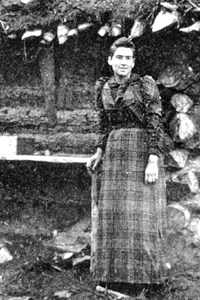
Emilie Fortin was born on January 4, 1872 in Saint-Joseph-d’Alma, Quebec. When she was fifteen, her family emigrated to Cohoes, New York where she met Nolasque Tremblay whom she married on December 11, 1893. In 1894 she claimed to be the first white woman to have crossed the Chilkoot Pass, but was actually the fourth after Bell Healy, “Dutch Kate” Wilson, and Bridget Mannion who we met yesterday.
The couple spent the winter in Miller Creek in a little log cabin. That year, Émilie decided to invite the miners to share their Christmas dinner. On the menu was stuffed rabbit, roast caribou, boiled brown beans, King Oscar sardines, dried potatoes, butter and sourdough bread and prune pudding. Her reputation quickly spread throughout the Yukon. In the spring, Émilie and her husband made a garden on the roof of their cabin and harvested an abundance of radishes and lettuce. After a trip south, they came back by the Chilkoot pass in the middle of the Gold Rush. In 1906, they travelled in Europe for four months. Until 1913, Mr. and Mrs. Tremblay walked from one mining claim to another in the Klondike. Later, they settled in Dawson. She opened a women’s clothes store that is now an historic building.
Émilie Tremblay was a very courageous woman who distinguished herself by her social involvement and her devotion to others. She was the founder of the Ladies of the Golden North, President of the Yukon Women Pioneers and a life member of the Daughters of the Empire. The numerous medals that she received and some of her souvenirs were placed in the Saguenay Museum in Quebec. She was godmother to 25 children in addition to raising the daughter of her sister who was a widow with 9 children to feed. Émilie kept open house for travellers, missionaries and widows. Msgr Bunoz called Émilie the “mother of the Klondike missionnairies”. During the war, Émilie knitted 263 pairs of socks for soldiers, in addition to the ones she gave as gifts.
Her husband Jack died in 1935 so she visited her family and friends in Quebec and the United States.
She spent the last years of her life in a retirement home in Victoria, B.C.
Émilie Tremblay died on April 22, 1949, at the age of 77. In 1985, to commemorate her exceptional devotion to others, the authorities named the first francophone school in the Yukon École Émilie-Tremblay.
She is seen above.
Yukon Government website celebrating women in the Yukon; franco.ca; Gates; Acadian roots.com






